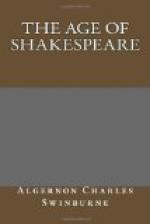The scenes in which the tragic underplot of Rowley’s tragedy is deftly and effectively wound up are full of living action and passion; that especially in which the revenge of a deserted wife is wreaked mistakingly on the villanous minion to whose instigation she owes the infidelity of the husband for whom she mistakes him. The gross physical horrors which deform the close of a noble poem are relieved if not beautified by the great style of its age—an age unparalleled in wealth and variety of genius, a style unmatchable for its union of inspired and imaginative dignity with actual and vivid reality of impassioned and lofty life.
No comparison is possible, nor if possible could it be profitable, between the somewhat rough-hewn English oak of Rowley’s play and the flawless Roman steel of Landor’s great Miltonic tragedy on the same subject. The fervent praise of Southey was not too generous to be just in its estimate of that austere masterpiece; it is lamentable to remember the injustice of its illustrious author to the men of Shakespeare’s day. I fear he would certainly not have excepted the noble work of his precursor from his general condemnation or impreachment of “their bloody bawdries”—a misjudgment gross enough for Hallam—or Voltaire when declining to the level of a Hallam. Landor was as headlong as these were hidebound, as fitful as they were futile; but not even the dispraise or the disrelish of a finer if not of a greater dramatic poet could affect the credit or impair the station of one on whose merits the final sentence of appreciation has been irrevocably pronounced by the verdict of Charles Lamb.




